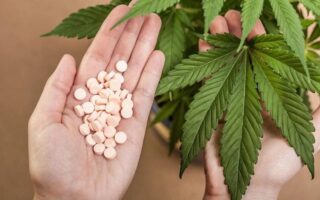Exploring the Varied Landscapes of Marijuana: A Comprehensive Guide to Its Forms
As the world of cannabis continues to evolve, so too does our understanding of its many forms and applications. From the classic flower to cutting-edge concentrates, marijuana now takes on a myriad of shapes and presentations, each offering unique experiences and benefits. Whether you’re a seasoned connoisseur or a curious newcomer, navigating this diverse terrain requires familiarity with its different manifestations. In this article, we embark on a journey through the various forms of marijuana—delving into their origins, characteristics, and uses. Join us as we illuminate the intricate tapestry of this ancient plant and discover how its many forms can enrich our lives in contemporary society.
Table of Contents
- Exploring the Diverse Forms of Marijuana and Their Unique Benefits
- A Deep Dive into Cannabis Consumption Methods: From Flower to Edibles
- Navigating the Effects: How Different Forms of Marijuana Impact Your Experience
- Choosing the Right Form for Your Needs: A Comprehensive Guide to Cannabis Selection
- Q&A
- To Wrap It Up
Exploring the Diverse Forms of Marijuana and Their Unique Benefits
As cannabis culture continues to flourish, the variety of marijuana forms available is vast and ever-expanding. Each type brings its own unique benefits, catering to different preferences and therapeutic needs. Here are a few notable forms:
- Buds/Flowers: The classic form, rich in cannabinoids, perfect for smoking or vaporizing.
- Edibles: Infused foods and beverages offer a discreet and tasty method of consumption, with effects that can last longer.
- Concentrates: Potent extracts, such as wax and shatter, provide a higher dose of cannabinoids, ideal for experienced users.
- Tinctures: Alcohol-based extracts allow for precise dosing and easy absorption, making them a popular choice for medical users.
- Topicals: Creams and balms infused with cannabinoids offer localized relief without psychoactive effects.
What makes these forms particularly appealing is their array of possible health benefits. For example, buds can relieve stress and anxiety, while edibles might help with chronic pain and insomnia. Concentrates are often sought for quick relief and euphoria, while tinctures provide a versatile option for those needing customized dosages. Additionally, topicals can assist with inflammation or skin conditions without the high, making them suitable for a wider audience.
| Form | Key Benefits |
|---|---|
| Buds/Flowers | Relaxation, stress relief |
| Edibles | Long-lasting effects, discreet |
| Concentrates | High potency, quick relief |
| Tinctures | Fast-acting, precise dosing |
| Topicals | Localized pain relief |
A Deep Dive into Cannabis Consumption Methods: From Flower to Edibles
The world of cannabis consumption is as diverse as the plant itself, offering various methods that cater to individual preferences and lifestyles. Flower, often referred to as bud, remains a staple in the cannabis community. Smoking or vaporizing the flower allows users to experience the full spectrum of cannabinoids and terpenes, delivering rich flavors and immediate effects. On the other hand, concentrates like wax, shatter, and oils have gained popularity for their potent effects and higher THC levels. These products are typically consumed via dabbing, which heats a small amount on a hot surface, producing a vapor that is inhaled. Other methods, such as tinctures, offer a discreet way to consume cannabis; these liquid extracts can be taken sublingually or added to food and drinks.
Edibles represent a unique consumption method that appeals to those looking for an alternative to smoking or vaping. With options ranging from gummies and chocolates to savory snacks, edibles allow for more creativity in how cannabis is consumed. However, the onset of effects can be delayed, leading to a potentially overwhelming experience for those unaccustomed to waiting for the effects to kick in. For users seeking a more tailored approach, capsules and topicals offer further diversity. Capsules provide precise dosing, ideal for medicinal users, while topicals deliver localized relief without psychoactive effects, making them perfect for individuals who want to enjoy the benefits of cannabis without the high.
| Consumption Method | Effects | Onset Time |
|---|---|---|
| Flower | Immediate effects with rich flavors | Instant |
| Concentrates | POTENT effects, high THC levels | Instant |
| Tinctures | Versatile and discreet | 15-45 minutes |
| Edibles | Long-lasting, intense high | 30-120 minutes |
| Capsules | Precise dosing | 30-120 minutes |
| Topicals | Localized relief, no high | Variable |
Navigating the Effects: How Different Forms of Marijuana Impact Your Experience
As you explore the diverse forms of marijuana, it’s crucial to recognize how each variant can shape your experience. Flower, often referred to as bud, is the most commonly known form and is enjoyed through smoking or vaporizing. It offers a wide range of aromas and flavors, bringing a natural essence that many enthusiasts appreciate. On the other hand, edibles present a different journey; they provide a delayed onset and more intense psychoactive effects. This is due to the way THC is metabolized when ingested, making timing and dosage vital factors. Users might indulge in snacks or beverages, relishing the creativity and variety these infused options offer.
Additionally, concentrates like wax, shatter, and oils elevate the potency significantly, packing a punch with higher THC levels. They can be dabbed or vaped, delivering swift effects that can be both exhilarating and overwhelming for newcomers. Meanwhile, topicals represent a unique category, providing localized relief without the psychoactive high, making them ideal for those seeking therapeutic benefits. Each form has its distinct attributes and potential impacts, demonstrating the versatility of marijuana as a whole.
Choosing the Right Form for Your Needs: A Comprehensive Guide to Cannabis Selection
When navigating the diverse world of cannabis, understanding the various forms available can greatly enhance your experience. Whether you’re a seasoned user or a curious newcomer, it’s essential to choose a format that aligns with your lifestyle and desired effects. The most common forms include:
- Flower: The traditional option, perfect for smoking or vaporizing.
- Concentrates: Potent extracts like wax, shatter, or oil ideal for experienced users seeking stronger effects.
- Edibles: Delicious infused foods or beverages that offer long-lasting effects but take time to kick in.
- Tinctures: Liquid extracts that can be taken sublingually for a discreet and quick way to consume cannabis.
- Topicals: Creams and balms that provide localized relief without the psychoactive effects, suitable for medicinal use.
In making your choice, consider the method of consumption that suits your preferences and needs. Each form has its unique benefits and challenges. The table below highlights some key characteristics to help you decide:
| Form | Onset Time | Duration | Experience Level |
|---|---|---|---|
| Flower | Immediate | 1-3 hours | Beginner – Expert |
| Concentrates | Immediate | 1-4 hours | Expert |
| Edibles | 30-120 minutes | 4-8 hours | Beginner – Intermediate |
| Tinctures | 15-45 minutes | 4-6 hours | Beginner |
| Topicals | 15-30 minutes | 2-8 hours | Beginner |
Q&A
Q&A: Exploring the Forms of Marijuana
Q1: What are the primary forms of marijuana available today?
A1: Marijuana, the versatile plant, comes in several primary forms: dried flowers (buds), edibles, concentrates, tinctures, topicals, and capsules. Each form has its unique properties and methods of consumption, allowing users to choose what suits their needs best.
Q2: How do dried flowers differ from other forms?
A2: Dried flowers, also known as buds or ganja, are the unprocessed, raw form of marijuana. Typically smoked in joints, pipes, or blunts, they preserve the plant’s natural cannabinoids and terpenes. Unlike concentrates, which are highly potent extracts, dried flowers provide a more balanced, holistic experience.
Q3: What are marijuana edibles, and how do they work?
A3: Marijuana edibles are food products infused with cannabis extracts. These can range from brownies and gummies to beverages. When consumed, the cannabinoids are metabolized in the liver, converting THC into a more potent form, leading to a more intense high and a longer duration of effects compared to smoking.
Q4: Can you explain what concentrates are?
A4: Concentrates are potent forms of marijuana that isolate and amplify specific cannabinoids and terpenes. Common types include oils, waxes, shatters, and live resin. These products typically require specialized equipment, like a dab rig or vape pen, for consumption, offering a more intense experience with smaller quantities.
Q5: What role do tinctures play in marijuana consumption?
A5: Tinctures are liquid cannabis extracts that are usually taken sublingually (under the tongue). They come in dropper bottles for easy dosing and provide a discreet way to consume marijuana. Tinctures offer a faster onset of effects than edibles, usually within 15 to 45 minutes, and allow for precise dosage adjustment.
Q6: How are topical products different from other marijuana forms?
A6: Topicals are cannabis-infused creams, balms, and lotions designed for external application. They primarily target localized pain or inflammation without producing psychoactive effects, as they do not enter the bloodstream. This makes them an attractive option for those seeking relief without the high.
Q7: Are cannabis capsules a popular choice for consumers?
A7: Yes, cannabis capsules offer a familiar form of consumption for many, providing a discreet and consistent way to manage dosage. They are easy to swallow and ideal for those who prefer not to inhale or taste cannabis. Capsules typically take longer to take effect, as they must be digested before the cannabinoids are absorbed.
Q8: How do users decide which form of marijuana to try?
A8: Choosing a form of marijuana often depends on individual preferences, desired effects, and lifestyle. Factors such as convenience, the method of action, potency, and personal tolerance can guide decisions. New users may start with milder forms, while seasoned consumers often explore a variety of options.
Q9: Are there any safety concerns associated with different forms?
A9: Each form of marijuana comes with its own safety considerations. Smoking can pose respiratory risks, edibles can lead to unintentional overconsumption due to delayed effects, and concentrates may be too potent for inexperienced users. It’s essential to research, start low, and go slow to ensure a safe and enjoyable experience.
Q10: What should someone new to marijuana know about these forms?
A10: Newcomers should be well-informed about the various forms and their effects. It’s wise to start with low doses, especially with edibles and concentrates, to gauge individual tolerance. Understanding how each form works and consulting knowledgeable sources can help ensure a positive and informed experience with marijuana.
To Wrap It Up
As we journey through the diverse landscape of marijuana forms, it becomes clear that this remarkable plant offers a spectrum of possibilities. From the time-honored tradition of hand-rolled joints to the innovative realms of edibles and concentrates, each form carries its own unique characteristics, effects, and cultural significance. Whether you are a seasoned connoisseur or a curious newcomer, understanding these variations not only enhances your experience but also deepens your appreciation for the complexities of cannabis. As society continues to evolve its relationship with marijuana, remaining informed empowers us to make thoughtful choices that align with our individual preferences and wellness goals. In a world where the conversation around this multifaceted plant is ever-changing, may we embrace knowledge, share experiences, and navigate the green frontier with curiosity and respect.


